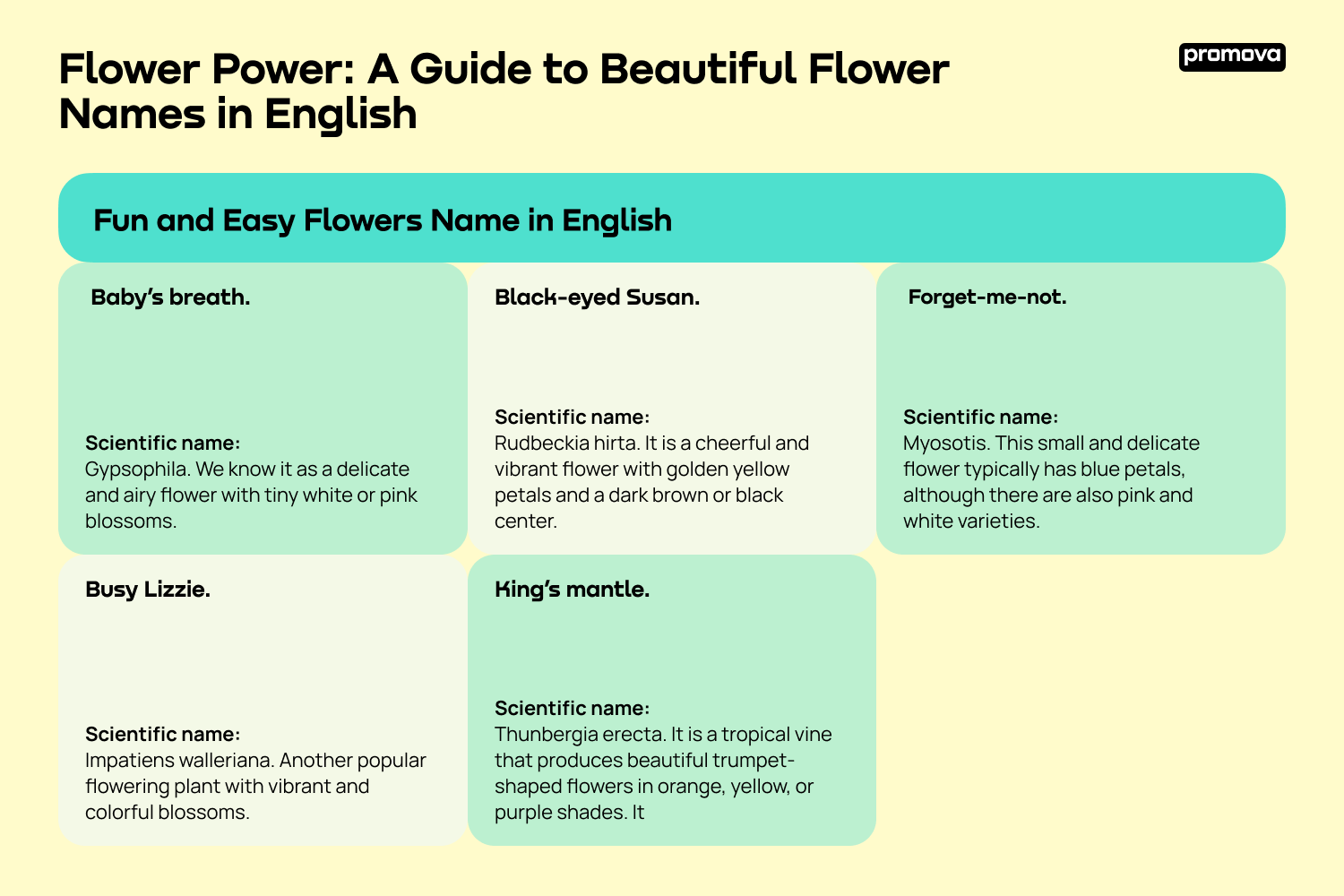Flower Power: A Guide to Beautiful Flower Names in English

Contents
People have always admired flowers for their beauty. And within the realm of vocabulary, English flower names hold a captivating power to express a wide range of emotions, create vivid metaphors, and add depth to our conversations and writings. Whether you are a language learner seeking to become fluent or just an admirer of the poetic beauty of flowers, this article is your guide through the enchanting world of floral expressions.
National Blossoms: Discovering Flowers of the World
We can’t imagine how many flowers and plants there are worldwide. But apparently, some specific English flower names are associated with different cities and even whole countries. Some were chosen because they perfectly describe the area’s beauty, while others have some cultural significance or historical context behind them. So, what flowers are we talking about?
- Rose. These beauties are known and widespread around the world. But not so long ago, in 1986, they were formally declared the national floral emblem of the United States. Ronald Reagan, the former president, said that Americans always hold a rose as a “symbol of life and love and devotion, of beauty and eternity.”
- Lotus. This flower holds immense cultural and spiritual significance in Asia, particularly India. The lotus is associated with purity, enlightenment, and the triumph of beauty over adversity. It is revered in Hindu, Buddhist, and Jain traditions, symbolizing divine beauty and spiritual awakening.
- Golden wattles. In August 1988, this beautiful flower became the national floral emblem of Australia. Its vibrant yellow blossoms represent the country’s resilience. This wonderful flower holds a special place in Australian culture. Aussies see it as a symbol of unity and the spirit of mateship.
- Sakura. Another name for this flower is the cherry blossom, and it is deeply cherished in Japan. Each spring, the nation celebrates Hanami, a tradition where people gather under blooming cherry trees to appreciate their outstanding beauty. The sakura represents the ephemeral nature of life; it reminds people to embrace the moment and find beauty in fleeting experiences.
- Tulip. This flower has special significance in the Netherlands, where it is considered the national floral emblem. Their vibrant colors and graceful form characterize tulips. They symbolize abundance, love, and the Dutch artistic legacy. The Netherlands is renowned for its tulip fields and the annual Keukenhof flower exhibition that attracts visitors from all over the world.
- Sunflower. The history behind this flower is sad and beautiful at the same time. It became the national floral emblem of Ukraine after the 1986 Chornobyl disaster. People were planting these flowers on contaminated fields as they helped extract toxins from the soil. Nowadays, sunflowers represent resilience and hope, and outstanding Ukrainian nature.
- White lily. Last but not least on our list is the national emblem of Italy. The white lily’s pure petals and elegant appearance represent purity, virtue, and the divine. This flower holds religious significance and is often associated with the Virgin Mary and the ideals of innocence and beauty.
All of these names of flowers in English tell us about cultural values, natural beauty, and historical origins. Each blossom conveys a story of the area and visually represents the country it is associated with.
State Flowers Name in English
If you still don’t believe that flowers play a significant part in many different areas, just think about this – each of the 50 U.S. states has its own floral emblem. Some earned this title very recently (for example, milkweed became Illinois’ state flower only in 2017), and others have been there for decades (like Vermont’s symbol, red clover, since 1893). Here are some other names of flowers in English associated with different states:
- California – golden poppy;
- Delaware – peach blossom;
- Hawaii – hibiscus;
- Indiana – peony;
- Michigan – apple blossom;
- Nebraska – goldenrod;
- New York – rose;
- Texas – Texas bluebonnet;
- Utah – sego lily;
- Washington – coast rhododendron.
Learning the names of flowers in English can not only expand your vocabulary but also allow you to make your conversations more poetic by expressing your thoughts with various floral metaphors. But if you think that the list of flower names does not go beyond common roses or daisies, you are mistaken! There are plenty of unusual and exciting floral terms, and we are about to tell you about them.
7
Fun and Easy Flowers Name in English
Most blossoms have two names – scientific (which usually comes from Latin) and casual (which most people know). These terms are sometimes similar; for example, the lotus is called the same in both cases. But there are numerous examples when the scientific titles of common flower names are too complex to memorize and pronounce. In these cases, the game of associations comes to the rescue, creating new, fun, and exciting names. Here are some popular examples:
- Baby’s breath.
Scientific name: Gypsophila. We know it as a delicate and airy flower with tiny white or pink blossoms. Due to its dainty appearance, it is often used as a filler in floral arrangements and bouquets. Baby’s breath is associated with purity, innocence, and everlasting love.
- Black-eyed Susan.
Scientific name: Rudbeckia hirta. It is a cheerful and vibrant flower with golden yellow petals and a dark brown or black center. Black-eyed Susans are named after a character from John Gay’s popular ballad.
- Forget-me-not.
Scientific name: Myosotis. This small and delicate flower typically has blue petals, although there are also pink and white varieties. As the name suggests, forget-me-not represents remembrance, true love, and fond memories.
- Busy Lizzie.
Scientific name: Impatiens walleriana. Another popular flowering plant with vibrant and colorful blossoms. It is characterized by its ability to thrive in shady conditions and its abundant blooms. Busy Lizzies are associated with joy, cheerfulness, and positive energy.
- King’s mantle.
Scientific name: Thunbergia erecta. It is a tropical vine that produces beautiful trumpet-shaped flowers in orange, yellow, or purple shades. It is named after the resemblance of its flowers to a monarch’s ceremonial robe. The king’s mantle symbolizes power, elegance, and regal beauty.
- Miss Willmott’s Ghost.
Scientific name: Eryngium giganteum. This intriguing and unique flower features silver-grey bracts and spiky blooms. It is known for the ghostly silvery hue of its flowers. It is named after Ellen Willmott, a gardener who always left a trail of seeds in every garden she visited.
- Love lies bleeding.
Scientific name: Amaranthus caudatus. Finally, this exciting and eye-catching flower with long, drooping clusters of vibrant red or purple flowers. It looks like blood dripping from a wound, so that comparison explains the name. In some countries, love lies bleeding symbolizes deep and passionate love, intense emotions, and even heartache.

Bonus! 5 Popular Flower-Related Idioms and Sayings
Native speakers like using idioms in daily conversations, and usually, they have at least a few for almost every discussion topic. And there is no surprise that you can see all flower types in famous expressions. Below, we’ve listed just some of the most common ones:
- Oops-a-daisy.
This idiomatic exclamation is usually used when someone makes a small mistake or has a minor accident. You can also say it to someone, especially a child, to console or encourage them after a stumble or a fall. Like many other flowers names in English, the term “daisy” here adds a playful and lighthearted tone to the expression. For example:
Oops-a-daisy, I dropped my pen on the floor.
She stumbled on the uneven sidewalk and exclaimed, “Oops-a-daisy!”
The little girl fell off her bike but quickly got up, brushing off the dirt, and said, “Oops-a-daisy!”
- A late bloomer.
We use this idiom when referring to or describing a person who develops or achieves their full potential later in life, compared to others who may have accomplished the same at a younger age. It is metaphorically related to a flower that takes more time to bloom or fully open than others. For example:
John was always considered a late bloomer academically, but now he’s excelling in his studies.
She didn’t start pursuing her passion for painting until her forties; she’s a true late bloomer.
Don’t worry if you haven’t found your career path yet – some people are late bloomers and discover their true calling later in life.
- No bed of roses.
This idiom describes a situation or task that is not as easy or pleasant as expected. It implies that life is not always smooth and comfortable and serves as a reminder that challenges and difficulties are inherent and that not everything will be effortless or enjoyable. For example:
Running a marathon is no bed of roses; it requires months of training and dedication.
I know it’s hard. Yet, you need to accept that life is no bed of roses, and challenges will always be an integral part of it.
I like being a parent, but it’s also no bed of roses with the sleepless nights and constant responsibilities.
- Wallflower.
Have you seen or read “The Perks of Being a Wallflower?” If yes, then you remember the main character, who tends to remain unnoticed or blend into the background during social gatherings or events – and this is precisely what “wallflower” means. The term originates from the idea of a flower growing against a wall, away from the center of attention. Calling someone a wallflower suggests they are shy, introverted, or avoid any active participation in social interactions. For example:
She remained a wallflower at the party, observing the conversations from a distance.
He’s usually a wallflower in social settings. He prefers to listen rather than participate in discussions.
The shy student was often a wallflower in class, rarely raising their hand to speak.
- Stop and smell the roses.
We want to end our lists of names of flowers and idioms with this famous expression. It encourages us to take the time to appreciate and enjoy the simple and beautiful things in life. It advises slowing down and savoring the present moment, just as one might pause to smell the pleasant fragrance of roses. For example:
With our busy lives, it’s important to take a moment to stop and smell the roses.
During our vacation, we made sure to stop and smell the roses, appreciating the beauty of each place we visited.
After a long day at work, she liked to relax in her garden, stopping to smell the roses and unwind.
Studying the Beauty of Flower Names with Promova
Even though flower names might not look as hard as challenging English grammar rules, memorizing and understanding them all require some skills. And if you are just starting your journey toward fluency, you will definitely need some help. But don’t worry about that – we’ve got you covered. At Promova, we can offer plenty of features to help students with different needs.
Let’s start with some classics – our personal and group lessons with professional tutors. This option should be your number one choice if you are tired of traditional tedious classes. After passing a quick test to determine your fluency level and specifying your studying goals, you immediately enter a friendly and supportive environment where you can reach your aims without any struggle. And if you are still hesitating, Promova always offers a free trial lesson; hop into this opportunity to glance at all the processes before making your final decision.
If you are satisfied with your proficiency but want to improve some specific skills, Promova has something for you as well. For example, our free Conversation Club is great for those seeking speaking practice. Here you can discuss various topics with people worldwide, find new friends, and enhance your communication skills.
Our convenient Promova app will become handy for those who prefer studying on the go. Just install it on your iOS or Android device and access unique learning materials, useful exercises, and a lot more helpful features. The opportunities are endless – the choice is yours.
Conclusion
Today, we want to finish with a quote. Carole Radziwill once said: “The best relationship has a gardener and a flower. The gardener nurtures, and the flower blooms.” But when it comes to learning English (or, basically, doing anything with your life), we become both the gardener and the flower. Only the effort we put into reaching our goals impacts the results we receive in the end. And the best thing is that only we can decide how to care about our own flowers.
FAQ
How can learning flower names enhance my English skills?
Firstly, it significantly expands your vocabulary and allows you to learn many new words. But it also helps you sound more natural when speaking English. Moreover, you start sharing your emotions and define experiences freely by using famous flower-related idioms, metaphors, or sayings.
Is there any symbolism behind different flower names?
There is indeed symbolism, not only in floral names but even in their colors. For example, a rose is commonly associated with love and passion. But different types of this color can express different types of love! White roses symbolize innocence and spiritual love, yellow – represent friendship and joy, and coral ones – desire.
What is the best literature to learn flower names?
You can choose from different options depending on your needs. For example, if you are keen to learn scientific names and definitions of flower names, you can select some professional literature like field guides or botanical books. If your goal is to find some poetry behind flowers, you can read the classic works of Shakespeare, Emily Dickinson, or Robert Frost.
Are there any practical exercises to learn the names of flowers in English?
There are plenty, but our all-time favorite is the fun and useful Scavenger hunt. The rules are pretty simple. You need a friend (or group of friends) and a task to find something (in our case, flowers). You can either write a list of flower names and look for them, or find some blooms first and then try to name them. This exercise is very exciting since it requires some physical actions and allows you to visualize and memorize different flower names.



Comments